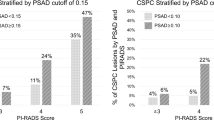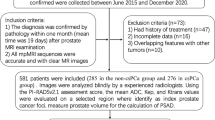Abstract
Introduction
While an elevated PSA significantly increases the risk of men harboring prostate cancer, many men with a persistently elevated PSA have negative prostate biopsies. More recently, multiparametric MRI (mpMRI) has had promising implications for the diagnosis of prostate cancer. We aim to investigate the diagnostic role of mpMRI in predicting the future diagnosis of prostate cancer in patients with an initial negative biopsy.
Methods
This study included all men with negative biopsies, elevated PSA and mpMRI. All patients had their age, PSA, and PSAd recorded. mpMRI lesions were classified using the PI-RADS 2 scoring system.
Results
mpMRI imaging was performed in 336 men with an initial negative biopsy, of whom 108, 111, 76 and 41 men underwent single, two, three and four biopsies, respectively. Of the 228 men with more than one biopsy, 115 patients were diagnosed with prostate cancer on further biopsies. Older patients and men with higher PSA, PSAd and PIRADS score had a significant risk to progress to cancer but only higher PSAd and higher PI-RADS score were significantly associated with clinically significant cancers. For clinically significant cancer; sensitivity and specificity of PI-RADS scoring was 86 and 45%, respectively, and a NPV of 87.6%. When combined with PSAd, NPV was 93%.
Conclusion
Men with benign prostatic biopsy and both PSAd < 0.15 and low PI-RADS score may avoid second biopsy. PI-RADS scoring system has a high sensitivity to diagnose clinically significant prostate cancer and repeat biopsy should be recommended in men with benign biopsy and high score.

Similar content being viewed by others
References
Welch HG, Fisher ES, Gottlieb DJ, Barry MJ (2007) Detection of prostate cancer via biopsy in the medicare-SEER population during the PSA era. J Natl Cancer Inst 99(18):1395–1400
Schröder FH, Hugosson J, Roobol MJ et al (2009) Screening and prostate-cancer mortality in a randomized European study. N Engl J Med 360(13):1320–1328
Rosenkrantz AB, Verma S, Choyke P et al (2016) Prostate magnetic resonance imaging and magnetic resonance imaging targeted biopsy in patients with a prior negative biopsy: a consensus statement by AUA and SAR. J Urol 196:1613
Mottet N, Bellmunt J, Bolla M et al (2017) EAU-ESTROSIOG guidelines on prostate cancer. Part 1: screening, diagnosis, and local treatment with curative intent. Eur Urol 71:618
Kotb AF, Tanguay S, Luz MA, Kassouf W, Aprikian AG (2011) Relationship between initial PSA density with future PSA kinetics and repeat biopsies in men with prostate cancer on active surveillance. Prostate Cancer Prostat Dis 14(1):53–57
Washino S, Okochi T, Saito K et al (2017) Combination of prostate imaging reporting and data system (PI-RADS) score and prostate-specific antigen (PSA) density predicts biopsy outcome in prostate biopsy naïve patients. BJU Int 119(2):225–233
Fascelli M, Rais-Bahrami S, Sankineni S et al (2016) Combined biparametric prostate magnetic resonance imaging and prostate-specific antigen in the detection of prostate cancer: a validation study in a biopsy-naive patient population. Urology 88:125–134
Boesen L, Nørgaard N, Løgager V, Thomsen HS (2017) Clinical outcome following low suspicion multiparametric prostate magnetic resonance imaging or benign magnetic resonance imaging guided biopsy to detect prostate cancer. J Urol 198:310–315
Futterer JJ, Briganti A, De Visschere P et al (2015) Can clinically significant prostate cancer be detected with multiparametric magnetic resonance imaging? A systematic review of the literature. Eur Urol 68:1045–1053
Ahmed HU, El-Shater Bosaily A, Brown LC et al (2017) Diagnostic accuracy of multi-parametric MRI and TRUS biopsy in prostate cancer (PROMIS): a paired validating confirmatory study. Lancet 389(10071):815–822
Schoots IG, Roobol MJ (2017) From PROMIS to PRO-MRI in primary prostate cancer diagnosis. Transl Androl Urol. 6(3):604–607
Wang RS, Kim EH, Vetter JM et al (2017) Determination of the role of negative magnetic resonance imaging of the prostate in clinical practice: is biopsy still necessary? Urology 102:190–197
Borofsky S, George AK, Gaur S et al (2018) What are we missing? False-negative cancers at multiparametric MR imaging of the prostate. Radiology 286(1):186–195
Jin BS, Kang SH, Kim DY et al (2015) Pathological upgrading in prostate cancer patients eligible for active surveillance: does prostate-specific antigen density matter? Korean J Urol 56(9):624–629
Jue JS, Barboza MP, Prakash NS et al (2017) Re-examining prostate-specific antigen (PSA) density: defining the optimal PSA range and patients for using PSA density to predict prostate cancer using extended template biopsy. Urology. 105:123–128
Distler FA, Radtke JP, Bonekamp D et al (2017) The value of PSA density in combination with PI-RADS™ for the accuracy of prostate cancer prediction. J Urol 198(3):575–582
Gnanapragasam VJ, Burling K, George A et al (2016) The prostate health index adds predictive value to multi-parametric MRI in detecting significant prostate cancers in a repeat biopsy population. Sci Rep 6:35364
Author information
Authors and Affiliations
Contributions
AFK: Data collection, data analysis and writing the manuscript. SS: Project development. TC: statistical review. MEH: Project development, management of patients and manuscript editing.
Corresponding author
Ethics declarations
Conflict of interest
The authors have no conflict of interest to declare.
Ethical approval
All procedures performed in studies involving human participants were in accordance with the ethical standards of the institutional and/or national research committee and with the 1964 Helsinki declaration and its later amendments or comparable ethical standards.
Informed consent
For this type of study formal consent is not required.
Rights and permissions
About this article
Cite this article
Kotb, A.F., Spaner, S., Crump, T. et al. The role of mpMRI and PSA density in patients with an initial negative prostatic biopsy. World J Urol 36, 2021–2025 (2018). https://doi.org/10.1007/s00345-018-2341-4
Received:
Accepted:
Published:
Issue Date:
DOI: https://doi.org/10.1007/s00345-018-2341-4




